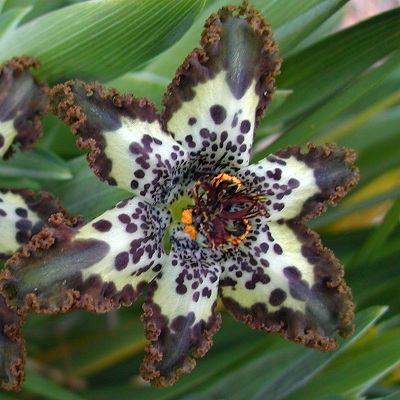"Starfish Iris"
Planting the bulbs When to plant -- Your bulbs (technically corms) will sprout in autumn, around late September/October (in the Southern Hemisphere, early April). Until then, store them in a paper bag. Or you may plant them in soil before autumn, but only if the soil can be kept dry until autumn. Either way, store them out of direct sunlight. Pot size -- Use a pot about 5-6 inches tall (12-15 cm) and wide enough so each bulb is about 2 inches (5 cm) from the next one, and from the edge of the pot. The pot needs drainage holes. If temperatures tend to get above the low 70s (23°C) in winter or spring, keep the roots cool by placing the pot inside a larger clay pot (fill any extra space with soil). Soil -- Use fast-draining soil. A typical mix is 1 part
quality potting soil Planting the bulb -- If you can't tell which end of the corm is the "top", just plant them sideways and they will straighten themselves out as they grow. The top of the bulb should be about 1½ to 2 inches (4-5 cm) under the surface (slightly deeper in warm climates, to keep the bulbs cool). In early October, water the soil lightly until it is slightly moist (not fully saturated). The bulbs should begin sprouting within a few weeks of watering them. Once they sprout, move them to a sunny spot. In hotter conditions, they may need some afternoon shade, otherwise full sun is best throughout winter. Watering -- Aim to keep the soil evenly moist throughout the growing season. Avoid letting it dry out completely, but also
don't keep it constantly saturated. If you're unsure if the soil has the proper moisture
in the root zone, use a
moisture meter Climate -- The Starfish Iris does best in mild, frost-free temperatures during its winter growing period. It grows best between 40 and 75 degrees F (4-24°C) from October through April in the Northern hemisphere (April to October in the Southern hemisphere). It can usually handle warmer temperatures provided that nights are cool (below 65°F / 18°C). It probably can tolerate an occasional, light frost, but i recommend protecting it from freezing temperatures. Lighting -- Mostly-sunny conditions are best throughout the winter & spring growing period. Some afternoon shade might be needed in warmer climates, especially during spring. Feeding -- This species has moderate fertilizer requirements. Feed about 2-3 weeks after they sprout, and again 2-3 months later. Use an all-purpose fertilizer that contains micronutrients. Avoid feeding after February. Dormancy care -- In late spring or summer, the leaves will begin to turn yellow and die back as the bulbs prepare for their summer dormancy. Reduce watering during this time, giving just enough water to keep the soil from drying out completely. Once the leaves have completely died back, you may remove the bulbs and store them in a paper bag in a cool spot until autumn.. or just leave them in their pot. Again, give just enough water to keep the soil from getting completely dry. Pests -- None that i'm aware of. Indoors, mealy bugs might grow on the bulbs. Have fun growing them! - Jeff Strange Wonderful Things
|
|||||||||


